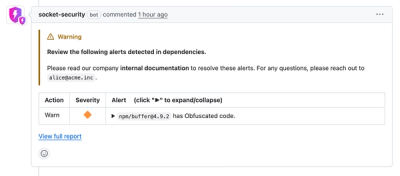
Security News
Crates.io Users Targeted by Phishing Emails
The Rust Security Response WG is warning of phishing emails from rustfoundation.dev targeting crates.io users.
web-translate
Advanced tools
Creating web applications that display text in a variety of written languages is a common need. One might think this is a solved problem and that simple solutions exist. I have not found any that fit the bill, so I created web-translate. This is an open source library that can be obtained via npm at https://www.npmjs.com/package/web-translate.
The web-translate library provides a set of JavaScript functions and a command that make language translation in web applications very easy! It is not specific to any framework and should work with all the popular choices including React, Vue, and Angular.
The translations are performed as a build step, so no cost for translation services is incurred during web application usage.
This library is English-centric from the standpoint that it assumes all translations will be driven from initial text that is English.
The goals for this library are:
The most highly recommended language translation services are the Google Cloud Translation API and the Yandex Translate Service. Both require an API key.
The Google Cloud Translation API requires setup of a Google Cloud Platform (GCP) project. The cost is $20 (USD) per million characters translated. To enable use of the "Cloud Translation API" and obtain an API Key:
The Yandex Translate Service used to have a free tier, but no longer does. The commercial tier pricing is documented at https://translate.yandex.com/developers/offer/prices. Currently the cost is $15 (USD) per million characters translated up to 50 million. The rates go down slowly above that. Information on obtaining a Yandex API key can be found at https://tech.yandex.com/translate/.
To use the web-translate package,
npm install web-translateTRANSLATE_ENGINE to "google" or "yandex".
When not set, this defaults to "yandex" because that has a free tier.API_KEY to the API key for the desired service.package.json file for your application."gentran": "generate-translations",The file src/generate-translations.js sets PUBLIC_DIR to static.
If this is not where your web app stores public files, change this value.
For example, React apps typically use a directory named public.
Create the file languages.json to describe the languages to be supported.
For example,
{
"Chinese": "zh",
"English": "en",
"French": "fr",
"German": "de",
"Russian": "ru",
"Spanish": "es"
}
It is important to get the language codes (like "en") correct because those are used to request translations. You can find a list of valid language codes at https://www.wikipedia.org/wiki/List_of_ISO_639-1_codes/
This file must be in a directory that is accessible at the domain of the web app.
For example, if your web application is running on localhost:3000
then an HTTP GET request to localhost:3000/languages.json
must return the content of this file.
For a React application created with create-react-app,
placing this file in the public directory will achieve this.
Use the i18n function to get translations.
This can be imported with import {i18n} from 'web-translate';
For example, when the language is Spanish then
calling i18n('Hello') might return "Hola".
The string passed to the i18n function can be
English text or a key used to lookup the translation
in a language-specific JSON file.
Keys are useful for long phrases, sentences, and even paragraphs.
For example, i18n('greet') might return
"Welcome to my wonderful web application!".
Translations for keys must be defined in language-specific JSON files.
For example, the file en.json could contain the following:
{
"contact": "For more information, contact Mark Volkmann.",
"greet": "Welcome to my wonderful web application!"
}
Translations of all the text for all supported languages
can be manually entered in language-specific JSON files
like es.json (for Spanish) and fr.json (for French).
However as we will see next, these files can be generated
using one of the supported translation services.
In some cases it may be desirable to use different translations.
Those provided by the translation service can be overridden by
creating a JSON file whose name starts with the language code,
followed by -overrides.json.
For example, the file es-overrides.json could contain
the following to change the translation for "Hello"
from "Hola" to "Oh La".
{
"Hello": "Oh La"
}
After creating or modifying these "overrides" files, generate translations again as described in the next section.
Manually looking up and specifying translations can be very tedious!
Translations files for all the languages to be supported
can be generated by simply running npm run gentran.
Here is a description of what this does.
languages.json.i18n function
in all the source files under the src directory
where source files are any with an
extension of "js", "jsx", "svelte", "ts", "tsx", or "vue".en.json.translations to a map of all the translations found
in an overrides file for the current language
(ex. fr-overrides.json).
If none exist then translations begins empty.en.json ...
translations.translations.translations to a new translation file for the current language.If you choose to generate the translation files,
and you should, remember not to manually edit them because
they will be overwritten the next time npm run gentran is run.
If the i18n function is passed a variable instead of literal string,
no translations will be provided. This is because tracing the flow
of the code to find all possible values is a very hard problem.
In these cases, manually enter the desired translations in the en.json file.
This will enable translations for all the other supported languages
to be generated.
It is easy to allow the user to change the current language. Here is an example of how this can be done in a React application. It should be somewhat similar for other frameworks. I welcome contribution of code for other frameworks to share here.
import React, {Component} from 'react';
import {
getLanguageCode,
getSupportedLanguages,
i18n,
setLanguage
} from 'web-translate';
import './App.css';
class App extends Component {
state = {languages: {}};
async componentDidMount() {
const languageCode = getLanguageCode();
const languages = await getSupportedLanguages();
this.setState({languageCode, languages});
}
changeLanguage = async event => {
const languageCode = event.target.value;
await setLanguage(languageCode);
this.setState({languageCode});
};
render() {
const {languageCode, languages} = this.state;
const languageNames = Object.keys(languages);
return (
<div className="App">
<div>
<label>Language:</label>
<select onChange={this.changeLanguage} value={languageCode}>
{languageNames.map(name => (
<option key={name} value={languages[name]}>
{name}
</option>
))}
</select>
</div>
<div>{i18n('Hello')}</div>
<div>{i18n('some-key')}</div>
</div>
);
}
}
export default App;
With watch and live reload (as supported by create-react-app), changes to the list of supported languages and their translations are made available in the running application seconds after they are saved.
Run npm run gentran again whenever any of the following occur:
languages.json.en.json.-overrides.json file.i18n with literal strings are added in any source file,
or the literal strings passed to existing calls are modified,
and translations for the new values are not already present
in all the language .json files.Some web applications may need to dynamically
generate text that requires translation.
This can be accomplished using the translate function.
It takes a "from" language code, a "to" language code,
and the text to be translated.
For example, to translate "I like strawberry pie!" from English to French,
const text = 'I like strawberry pie!';
const translatedText = await translate('en', 'fr', text);
This requires ensuring that the TRANSLATE_ENGINE and API_KEY
environment variables are set in the environment
where the web app is running.
Bear in mind that run-time translation will incur per user session charges from the selected translation service. Avoid using this approach when possible.
In our example application, we begin with the following files:
{
"English": "en",
"French": "fr",
"Spanish": "es"
}
{
"some-key": "My English key"
}
{
"Hello": "Hola"
}
Inside the render method we have:
<div>{i18n('Hello')}</div>
<div>{i18n('some-key')}</div>
Before running npm run gentran when the application is rendered
we see the the languages "English", "French", and "Spanish"
in the language dropdown with "English" selected.
We also see "Hello" and "My English Key"
as the results of the i18n calls.
Selecting "French" from the dropdown
displays "Hello" and "some-key".
This happens because the file fr.json does not yet exist.
Selecting "Spanish" from the dropdown
displays "Hola" and "some-key".
We see "Hola" because that is the translation for "Hello"
in the es.json file.
We see "some-key" because es.json does not yet
provide a translation for that key.
Run npm run gentran. This generates the files es.json and fr.json
which will now contain translations for both "Hello" and "some-key".
Depending on your build process, the application may automatically
re-render in the browser.
When "French" is selected from the dropdown
we see "Bonjour" and "Ma clé anglaise" which are
the French translations for "Hello" and "My English Key".
When "Spanish" is selected we see still "Hola",
but we now see the Spanish translation
for "My English Key" which is "Mi clave en inglés".
Add the following lines to languages.json:
"German": "de",
"Russian": "ru"
Run npm run gentran again.
The language dropdown will now contain "German" and "Russian".
Selecting these languages will display their translations.
Add the following in App.js:
<div>{i18n('Where is your pencil?')}</div>
Run npm run gentran again.
We now see that text for English.
Select other languages from the dropdown
to display the translation for this text.
Sometimes the translations provided by the translation service
will not be ideal for the application.
To override translations, create a language-specific
-overrides.json file.
For example, to display "Oh La" instead of "Hola"
for the Spanish translation of "Hello", create the
file es-overrides.json with the following content:
{
"Hello": "Oh La"
}
Run npm run gentran again.
Select "Spanish" from the dropdown.
The new translation for "Hello" in Spanish will be displayed.
Translation text can contain placeholders for inserting dynamic text.
For example, en.json could contain the following line:
"greet": "Hello ${name}, today is ${dayOfWeek}.",
To use this, pass a second argument to i18n that is an object
where the keys are the placeholder names
and the values are the values to be inserted.
For example,
i18n('greet', {name: 'Mark', dayOfWeek: 'Tuesday'});
Translation text can contain HTML tags that are not translated.
For example, en.json could contain the following line:
"greet": "<i>Please</i> be <b>careful<b>!",
web-translate uses code from the npm package "translate" from Francisco Presencia (franciscop on GitHub). See https://www.npmjs.com/package/translate. Thank you Francisco!
Thanks to AJ Levinson for details on getting a Google Cloud Platform API key!
web-translate provides the simplest approach to language translations in web applications that I have seen! Please post suggestions for improvements and any issues at https://github.com/mvolkmann/web-translate/issues.
FAQs
supports language translation in web applications
The npm package web-translate receives a total of 3 weekly downloads. As such, web-translate popularity was classified as not popular.
We found that web-translate demonstrated a not healthy version release cadence and project activity because the last version was released a year ago. It has 1 open source maintainer collaborating on the project.
Did you know?

Socket for GitHub automatically highlights issues in each pull request and monitors the health of all your open source dependencies. Discover the contents of your packages and block harmful activity before you install or update your dependencies.

Security News
The Rust Security Response WG is warning of phishing emails from rustfoundation.dev targeting crates.io users.

Product
Socket now lets you customize pull request alert headers, helping security teams share clear guidance right in PRs to speed reviews and reduce back-and-forth.

Product
Socket's Rust support is moving to Beta: all users can scan Cargo projects and generate SBOMs, including Cargo.toml-only crates, with Rust-aware supply chain checks.